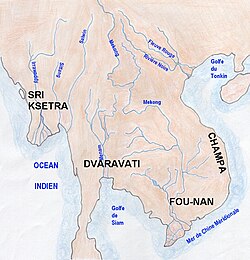
Back فونان Arabic Фунань Byelorussian হ্বূণন Bengali/Bangla Regne de Funan Catalan Funan German Reino de Funan Spanish Funanin kuningaskunta Finnish Fou-nan French Funan Hungarian Kerajaan Funan ID
Funan ហ៊្វូណន (Khmer) | |||||||
|---|---|---|---|---|---|---|---|
| 50 CE–627 | |||||||
 Map of indianized kingdoms of Indochina (1st to 9th centuries CE) | |||||||
| Capital | Vyadhapura | ||||||
| Common languages |
| ||||||
| Religion | |||||||
| Government | Mandala kingdom | ||||||
| Historical era | Classical era | ||||||
• Establishment | 50 CE | ||||||
• Chenla secession | 550 | ||||||
• Chenla conquest | 627 | ||||||
| Currency | Native coins | ||||||
| |||||||
| Today part of | |||||||
| History of Cambodia |
|---|
| Early history |
| Post-Angkor period |
| Colonial period |
| Independence and conflict |
| Peace process |
| Modern Cambodia |
| By topic |
|
|
Funan (Chinese: 扶南; pinyin: Fúnán; Khmer: ហ៊្វូណន, romanized: Hvunân, Khmer pronunciation: [fuːnɑːn]; Vietnamese: Phù Nam, Chữ Hán: 夫南; Sanskrit: व्याधपूर, Vyādhapūra) was the name given by Chinese cartographers, geographers and writers to an ancient Indianized state—or, rather a loose network of states (Mandala)[1][2]—located in mainland Southeast Asia covering parts of present-day Cambodia, Thailand and Vietnam that existed from the first to sixth century CE. The name is found in Chinese historical texts describing the kingdom, and the most extensive descriptions a name the people of Funan gave to their polity. Some scholars argued that ancient Chinese scholars has found the records from Yuán Shǐ, the history records of Yuan Dynasty. "Syam Kok and Lo Hu Kok, formerly the Kingdom of Funan, were located to the west of Linyi Kok (Champa Kingdom in central Vietnam). The maritime distance was from the capital of Linyi Kok to the capital of Funan Kok. They are separated by about 3,000 li."
Like the very name of the kingdom, the ethno-linguistic nature of the people is the subject of much discussion among specialists. The leading hypotheses are that the Funanese were mostly Mon–Khmer, or that they were mostly Austronesian, or that they constituted a multi-ethnic society. The available evidence is inconclusive on this issue. Michael Vickery has said that, even though identification of the language of Funan is not possible, the evidence suggests that the population was Khmer.[3] However, several studies demonstrates that inhabitants of Funan probably spoke Malayo-Polynesian languages, as in neighboring Champa.[4][5] The results of archaeology at Oc Eo have demonstrated "no true discontinuity between Oc Eo and pre-Angkorian levels", indicating ancient Mon-he region may have gone as far back as the 4th century BCE. Though regarded by Chinese authors as a single unified polity, some modern scholars suspect that Funan may have been a collection of city-states that sometimes were at war with one another and at other times constituted a political unity.[6] From archaeological evidence, which includes Roman, Chinese, and Indian goods excae centre of Óc Eo in southern Vietnam, it is known that Funan must have been a powerful trading state.[7] Excavations at Angkor Borei in southern Cambodia have likewise delivered evidence of an important settlement. Since Óc Eo was linked to a port on the coast and to Angkor Borei by a system of canals, it is possible that all of these locations together constituted the heartland of Funan.
- ^ Martin Stuart-Fox (2003). A Short History of China and Southeast Asia: Tribute, Trade and Influence. Allen & Unwin. p. 29. ISBN 978186489545.
{{cite book}}: Check|isbn=value: length (help) - ^ Dougald JW O′Reilly (2007). Early Civilizations of Southeast Asia. Altamira Press. p. 194.
- ^ Michael Vickery, "Funan reviewed: Deconstructing the Ancients", Bulletin de l'École Française d'Extrême Orient XC-XCI (2003–2004), pp. 101–143
- ^ Trude Jacobsen (2016). "Funan, Kingdom of". The Encyclopedia of Empire. pp. 1–2. doi:10.1002/9781118455074.wbeoe059. ISBN 978-1-118-44064-3.
- ^ Minh Giang Vu (2022). "FUNAN (Phu Nam) from a new perspective". Journal of Social Science and Humanities. 64 (3): 71–85. doi:10.31276/VMOSTJOSSH.64(3).71-85.
- ^ Hà Văn Tấn, "Oc Eo: Endogenous and Exogenous Elements", Viet Nam Social Sciences, 1–2 (7–8), 1986, pp.91–101.
- ^ Lương Ninh, "Funan Kingdom: A Historical Turning Point", Vietnam Archaeology, 147 3/2007: 74–89.